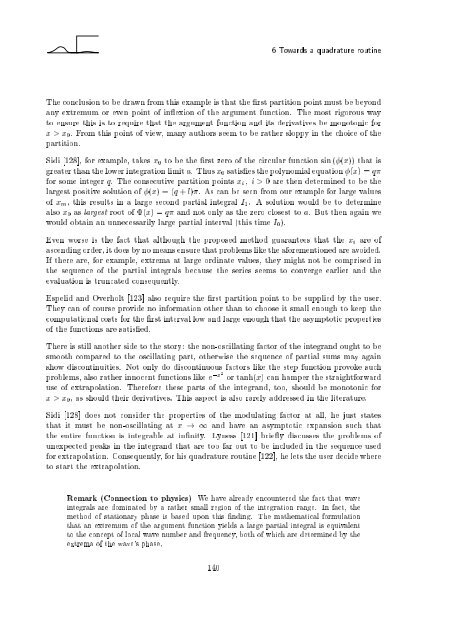Wave Propagation in Linear Media | re-examined
Wave Propagation in Linear Media | re-examined
Wave Propagation in Linear Media | re-examined
You also want an ePaper? Increase the reach of your titles
YUMPU automatically turns print PDFs into web optimized ePapers that Google loves.
6Towards a quadratu<strong>re</strong> rout<strong>in</strong>e<br />
The conclusion to be drawn from this example is that the rst partition po<strong>in</strong>t must be beyond<br />
any ext<strong>re</strong>mum or even po<strong>in</strong>t of <strong>in</strong> exion of the argument function. The most rigorous way<br />
to ensu<strong>re</strong> this is to <strong>re</strong>qui<strong>re</strong> that the argument function and its derivatives be monotonic for<br />
x>x0. From this po<strong>in</strong>t of view, many authors seem to be rather sloppy <strong>in</strong> the choice of the<br />
partition.<br />
Sidi [128], for example, takes x0 to be the rst zero of the circular function s<strong>in</strong> ( (x)) that is<br />
g<strong>re</strong>ater than the lower <strong>in</strong>tegration limit a. Thus x0 satis es the polynomial equation (x) =q<br />
for some <strong>in</strong>teger q. The consecutive partition po<strong>in</strong>ts xi ; i>0 a<strong>re</strong> then determ<strong>in</strong>ed to be the<br />
largest positive solution of (x) =(q+l) . As can be seen from our example for large values<br />
of xm, this <strong>re</strong>sults <strong>in</strong> a large second partial <strong>in</strong>tegral I1. A solution would be to determ<strong>in</strong>e<br />
also x0 as largest root of (x) =q and not only as the zero closest to a. But then aga<strong>in</strong> we<br />
would obta<strong>in</strong> an unnecessarily large partial <strong>in</strong>terval (this time I0).<br />
Even worse is the fact that although the proposed method guarantees that the xi a<strong>re</strong> of<br />
ascend<strong>in</strong>g order, it does by no means ensu<strong>re</strong> that problems like the afo<strong>re</strong>mentioned a<strong>re</strong> avoided.<br />
If the<strong>re</strong> a<strong>re</strong>, for example, ext<strong>re</strong>ma at large ord<strong>in</strong>ate values, they might not be comprised <strong>in</strong><br />
the sequence of the partial <strong>in</strong>tegrals because the series seems to converge earlier and the<br />
evaluation is truncated consequently.<br />
Espelid and Overholt [123] also <strong>re</strong>qui<strong>re</strong> the rst partition po<strong>in</strong>t to be supplied by the user.<br />
They can of course provide no <strong>in</strong>formation other than to choose it small enough to keep the<br />
computational costs for the rst <strong>in</strong>terval low and large enough that the asymptotic properties<br />
of the functions a<strong>re</strong> satis ed.<br />
The<strong>re</strong> is still another side to the story: the non-oscillat<strong>in</strong>g factor of the <strong>in</strong>tegrand ought tobe<br />
smooth compa<strong>re</strong>d to the oscillat<strong>in</strong>g part, otherwise the sequence of partial sums may aga<strong>in</strong><br />
show discont<strong>in</strong>uities. Not only do discont<strong>in</strong>uous factors like the step function provoke such<br />
problems, also rather <strong>in</strong>nocent functions like e ,x2 or tanh(x) can hamper the straightforward<br />
use of extrapolation. The<strong>re</strong>fo<strong>re</strong> these parts of the <strong>in</strong>tegrand, too, should be monotonic for<br />
x>x0, as should their derivatives. This aspect is also ra<strong>re</strong>ly add<strong>re</strong>ssed <strong>in</strong> the literatu<strong>re</strong>.<br />
Sidi [128] does not consider the properties of the modulat<strong>in</strong>g factor at all, he just states<br />
that it must be non-oscillat<strong>in</strong>g at x ! 1 and have an asymptotic expansion such that<br />
the enti<strong>re</strong> function is <strong>in</strong>tegrable at <strong>in</strong> nity. Lyness [121] brie y discusses the problems of<br />
unexpected peaks <strong>in</strong> the <strong>in</strong>tegrand that a<strong>re</strong> too far out to be <strong>in</strong>cluded <strong>in</strong> the sequence used<br />
for extrapolation. Consequently, for his quadratu<strong>re</strong> rout<strong>in</strong>e [122], he lets the user decide whe<strong>re</strong><br />
to start the extrapolation.<br />
Remark (Connection to physics) We have al<strong>re</strong>ady encounte<strong>re</strong>d the fact that wave<br />
<strong>in</strong>tegrals a<strong>re</strong> dom<strong>in</strong>ated by a rather small <strong>re</strong>gion of the <strong>in</strong>tegration range. In fact, the<br />
method of stationary phase is based upon this nd<strong>in</strong>g. The mathematical formulation<br />
that an ext<strong>re</strong>mum of the argument function yields a large partial <strong>in</strong>tegral is equivalent<br />
to the concept of local wave number and f<strong>re</strong>quency, both of which a<strong>re</strong> determ<strong>in</strong>ed by the<br />
ext<strong>re</strong>ma of the wave's phase.<br />
140












